|
Question: When is a vintage pen not a vintage pen? Answer: When
it’s a Conway Stewart Churchill ‘Red Ripple’!
I’ve always liked the look of the Churchill since it was introduced
a couple of years ago as Conway Stewart’s ‘flagship’ pen, competing
head on with the big boys such as the Pelikan M1000 from Germany. The fact that
it was hand made by the last of the great British prestige pen makers was an important
factor for me, and that the design harked back to the bygone age of vintage pens,
but using some very attractive modern resins and in some cases the legendary casein
– add to this the cachet of the commemorative association with our great
war leader, Sir Winston S. Churchill, made it an almost irresistible purchase.
Nonetheless, price put me off for some time – the Churchill range is
not cheap, and though it does offer good value for money, other expenses had a
grip on my wallet. However, earlier this year, a new version of the Churchill
was released, this time in the legendary red ‘woodgrain’ hard rubber
or ‘ebonite/vulcanite’ of the 1920’s. A ‘Red Ripple Churchill’?
What an amazing idea! Seeing one or two people on Pentrace wax lyrical about this
pen, and following the Stylophiles review of March 2003, I decided I just had
to have one – it was simply a matter of time.
A couple of weeks ago, this particular dream came true, and I found myself
in the position to order a lever-filling Churchill Red Ripple, which I chose to
do direct from the new Conway Stewart website, which offers a 10% discount to
those who sign up to their online collectors club, which is free. However, there
was a problem with the online payment system at the time, so I found myself ordering
one by telephone – I still got my discount though (grin).
The pen took a week to arrive, and thanks to the courtesy of Don Yendle, Managing
Director of Conway Stewart, it was then delivered promptly, and carefully numbered
by him personally with its limited edition number: 209 of 500. A minor disappointment
was that it was delivered with a medium nib rather than the Italic Fine which
I had ordered; however, thanks again to the courtesy of Don Yendle, an IF nib
was immediately dispatched to me, and I received and fitted it the next day. Don
also kindly sent 4 bottles of Conway Stewart ink in compensation for the minor
inconvenience – thanks Don!
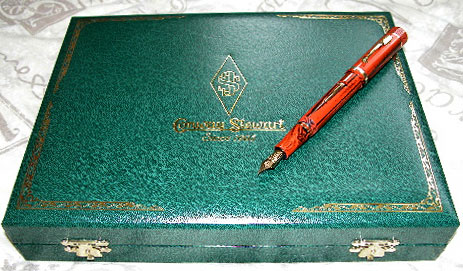
Churchill Red Ripple atop its ‘casket’
I had already enjoyed the pleasurable sensation of opening the large mailing
box and discovering a further box carefully wrapped in tissue paper sealed with
a Union Jack sticker with BRITISH MADE proudly emblazoned across it. This was
a bit of a shock as you don’t often see that these days!
Under the wrap was a fine green cloth covered box, gold-embossed with the
Conway Stewart logo ‘Since 1905’, and within that was yet another
box – an even more spectacular green ‘leatherette’ padded-topped
casket, again gold-embossed and this time hinged and clasped with brass fittings.
Within that casket, carefully opened by yours truly, was a small (actually not
so small!) object of desire – the Red Ripple Churchill. Alongside, on a
padded bed of what appeared to be silk, lay the well-known book of Churchill quotes,
a substantial Don Antonio Churchill cigar in its tube, and a bottle of blue Conway
Stewart ink. One has to say, you can’t fault Conway Stewart on their presentation.

Box of delights
Physical Characteristics – in comparison with the Pelikan M1000
The highly-polished and very tactile hard rubber material from which the Churchill
is fashioned is very pleasant to handle, and warms to the touch – it almost
feels alive, unlike hard acrylic or other resins. Initially, I was just in awe
of the simple beauty of this traditional mode of construction. I picked the pen
up and just turned it over and over, removing the (huge!) cap to see how the pattern
ebbed and flowed around the barrel of the pen, in this case nicely lined up with
the filling lever and nib. Even the top of the cap has a swirl just like a black
and red spinning spiral galaxy. The black in red woodgrain effect, uniquely patterned
in every pen and therefore particularly suited to a limited edition, is remarkable,
and though not uncommon in the better quality pens of the early 20th century,
is not something I would ever have expected to see in a modern pen, though I hear
more manufacturers are experimenting with this material now. As has been said
elsewhere, it perfectly suits that most vintage of modern pens – the Conway
Stewart Churchill – sending it back through time to those years between
the wars when the future seemed bright and everything was exciting and new.
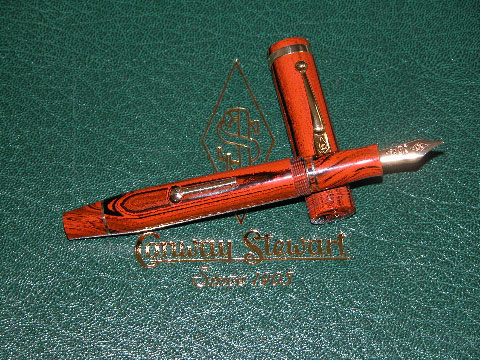
Conway Stewart Churchill Red Ripple
Being also the owner of a Pelikan M1000, a fine writing instrument of similar
stature and likewise a legend in its own lifetime, gave me a useful point of comparison
when examining the Churchill in detail.

Churchill and Pelikan M1000 - unposted
A closer look at the Churchill’s fixtures and fittings revealed that
everything was perfectly in place. As a result of receiving the incorrect Medium
nib, I had now however to perform one simple operation: gripping nib and feed
carefully with index finger and thumb, I removed both with a single pull, and
aligning the subsequently received Italic Fine nib with the separate feed by eye,
I pushed both back into the section with no difficulty, and alignment seemed fine.
In fact, the nib and section had already been lined up with the filling lever
during assembly, a nice point that balances the look of the pen. Plainly, the
Pelikan system of unified nib and feed units is more versatile, but how often
are you likely to want change your nib in practice?

Churchill and Pelikan M1000 on a vintage
bakelite pen tray (early 1940's)
It’s another nice detail point on the Churchill that the trim rings
are solid gold rather than plated, and also that those on the section are placed
just below the threads rather than on the end of the section, thus avoiding any
potential corrosion or wear which might be caused over time by dipping in ink
and wiping, a bone of some contention in some quarters with other pens, modern
Pelikans included.
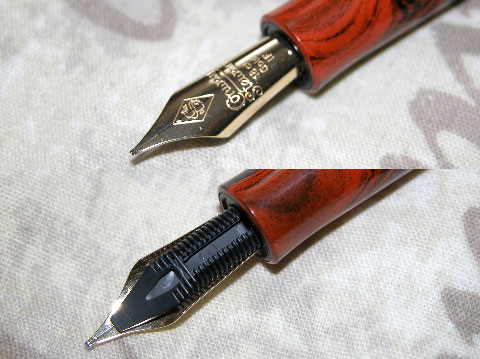
The Churchill Italic Fine nib –
italic ground on top, fine tip below
The single tone 18k solid gold nib of the Churchill is a little smaller than
that of the M1000, and less ornate, without all the two-tone scrolly decoration
of the nonetheless excellent Pelikan nibs. Less flashy, but more in keeping with
the vintage ethos of the Churchill. I was now, however, in for a big – and
rather pleasant - surprise. On closer examination, I discovered that the Italic
Fine nib was not, as I had assumed, simply a fine italic; it was in fact a dual-purpose
nib with a standard fine tip (leaning towards medium) with a fine cursive italic
tip ground on top, offering both straightforward writing and excellent line variation
at will! I have not seen this mentioned anywhere else, including on Conway Stewart’s
website, where you can buy the nibs separately up to Italic 2B, so it was a bit
of a shock. Nonetheless, I have since discovered this to be a very versatile and
pleasurable writing combination, once one has gotten used to the odd sensation
of writing with the nib upside-down! All the more, so I am informed, vintage in
character, which fits in once again with the Churchill ethos.
The Churchill’s section is in fact a little longer than that of the
M1000, which raises the Churchill’s threads higher by about 1 centimetre
and makes it more comfortable to hold, with my average-sized fingers neatly avoiding
the threads as a result. With a barrel about a centimetre longer than the M1000,
the lighter material of the Red Ripple Churchill nonetheless balances very well
unposted, and tapers down to the section, making it much easier and more comfortable
to handle than one would expect from the size.
Again in comparison to the M1000, the Churchill, at least in Red Ripple, is
noticeably better balanced when unposted; the M1000, with its heavier acrylic
and brass fittings for the (superb) piston-filling mechanism, is significantly
balanced towards the end of the barrel. The lighter Churchill, with the less advanced
but equally lighter and better-balanced lever-fill mechanism, does not suffer
from this and is noticeably more comfortable to hold. When posted, lengths are
similar, but both pens tend to assume the aspect of a baseball bat and are rather
unwieldy when posted. I prefer to use both unposted unless I wish to frighten
a Mont Blanc 149 user (grin).
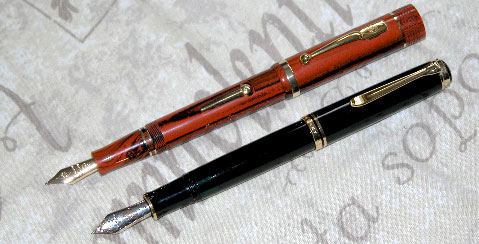
Churchill and M1000, caps posted
Here, of course, the similarities end, with the completely different filling
mechanisms defining use.
The Churchill in Use
OK, let’s face it – the ultimate
European classic pen filling system is the Pelikan piston – but the rest
of the world mostly went for lever-fillers, with a few honourable exceptions.
Surprisingly, the German piston-fillers survived the wholesale demise of the mass
fountain pen market, while cartridge/converter systems wiped the floor with what
was left of the lever-filler market. Today, though, the lever-filler is undergoing
something of a revival, and is perhaps best represented in modern pens by the
Conway Stewart range.
Putting the Churchill lever filler up against the M1000 piston filler is an
interesting contest, and I guess I’d have to say the piston has the edge
in precision and potential reliability, if not nostalgia value. On the other hand,
the lever system is mechanically simpler and easier to fix. I’ve not yet
been able to measure the precise quantity of ink taken up by both pens, but my
Churchill has been seen to deliver 22 drops of ink and the M1000, 28 drops. Make
of it what you will – the debate about drop size goes on! I’ve seen
it suggested that the Churchill sac is smaller than the inside of the tube –
this would make sense as there needs to be room for the press-bar, lever box and
expansion.

The Churchill filling lever
I’ve also heard of problems with Churchill ink sacs mentioned on Pentrace.
Suffice to say there are no such problems with this one. Don Yendle tells me that
there were major problems with some rubber sacs melting – Pentracers will
recall the problems earlier this year with a batch of melting sacs from Wood Bin
of Canada, due to a missing ingredient in the process. This faulty batch caused
sac problems with Conway Stewart pens at the time. That problem no longer applies
to current production, of course, but Conway Stewart continues to replace any
problem sacs in their pens as they surface, as part of their ongoing commitment
to customer service.
One or two reports of Churchill lever problems have also surfaced on Pentrace,
but Don Yendle does not believe that there is any serious general problem in this
regard. Nonetheless, Conway Stewart are not complacent about faults and stand
firmly behind their 1 year warranty. Anyway, problems with other pens aside, there
were none with this particular Churchill, filling nicely with Conway Stewart ink
and needing no more than two lever operations.
Writing with the Churchill Red Ripple is something of a revelation. Because
of its light weight, it balances, as I have mentioned, exceptionally well, and
because of the gradual taper down to the end of the section, fits easily in the
hand, like a smaller pen. After filling, it wrote well first time, though it did
not start with the first stroke. On the second stroke, however, the ink began
to flow – copiously! Since that first hesitant stroke it has started first
time, every time, and not skipped a beat – good news indeed by modern standards.
The unexpected but very welcome ‘dual’ nib – dubbed an Italic
Fine by Conway Stewart – has proven to really be the icing on the cake,
with the immediately available options of a standard ‘fine’ tip and
a cursive italic tip changeable by simply rotating the pen in the hand. Two nibs
in one, two styles instantly accessible – what could be more convenient?
And yes, both sides of the nib are great writers, the fine being very smooth,
the cursive italic being more toothsome, with just the right edge to give feedback
to those flourishing strokes. Is there any flex to this 18ct nib? Yes, a hint,
similar to that in the springy M1000 nibs, but no true semi-flex as in vintage
Pelikan nibs. Nonetheless, a very pleasant writing experience by modern standards
in particular.
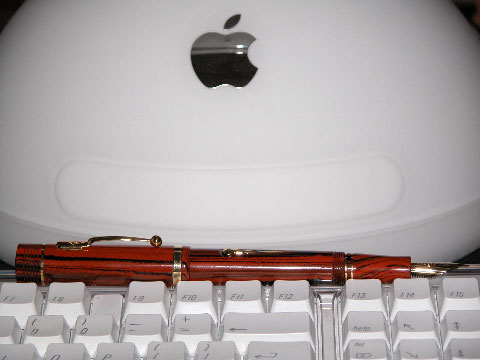
My two favourite correspondence tools
– Churchill and iMac! Both are supremely functional and yet also a pleasure
to use
I’ve now written a large pile of postcards and a few snail letters with
this pen, as well as some practice scrawling, without so far exhausting that first
fill. Time will tell on the writing capacity and long-term reliability of this
particular Red Ripple Churchill, but it has already given me a great deal of pleasure
and will be, I believe, a true ‘lifetime’ pen.
In the final analysis, which would I keep if forced to use only one pen –
the Pelikan or the Conway Stewart? I have to say that, despite its German efficiency
and many excellent qualities, the M1000 would be shown the door – the Conway
Stewart is noticeably more comfortable and fun to use, it has a truly ‘vintage’
ethos, and then there is that “Made in Britain’ sticker... But happily,
I’m in the fortunate position of being able to keep both pens, which now
have a permanent place together on my desk at home, a Mottishawed broad cursive
italic fitted to the Pelikan, perfectly complementing the versatile ‘Italic
Fine’ of the Conway Stewart. What more could I ask?
Stuart Williams
For further information on the Churchill and Conway Stewart in general, check
out the official UK website: http://www.conwaystewart.co.uk
Pens may be purchased directly from the website, or from many excellent dealers
worldwide, including some Pentrace sponsors. Prices vary, so shop around!
|